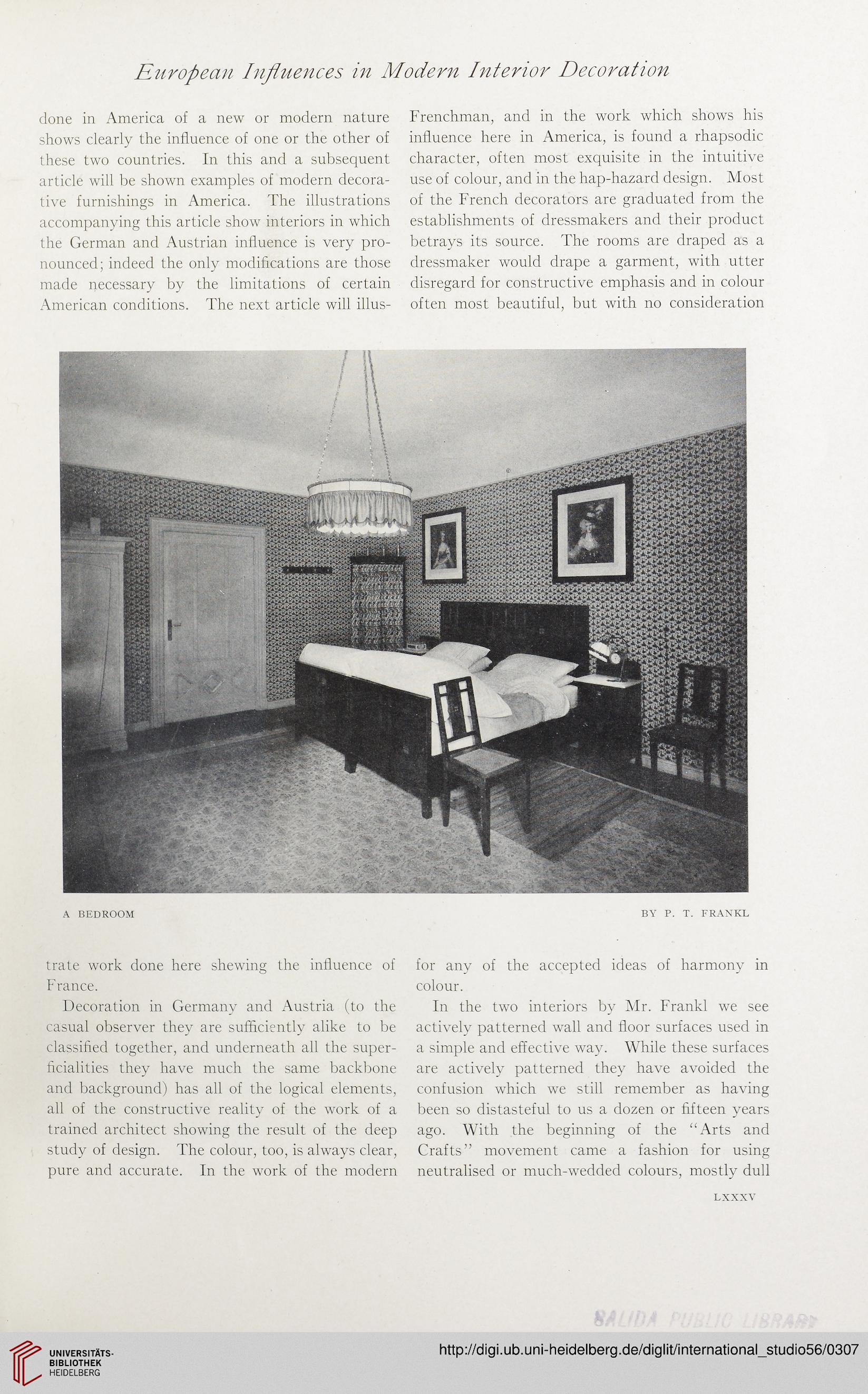European Influences in Modern Interior Decoration
done in America of a new or modern nature
shows clearly the influence of one or the other of
these two countries. In this and a subsequent
article will be shown examples of modern decora-
tive furnishings in America. The illustrations
accompanying this article show interiors in which
the German and Austrian influence is very pro-
nounced; indeed the only modifications are those
made necessary by the limitations of certain
American conditions. The next article will illus-
Frenchman, and in the work which shows his
influence here in America, is found a rhapsodic
character, often most exquisite in the intuitive
use of colour, and in the hap-hazard design. Most
of the French decorators are graduated from the
establishments of dressmakers and their product
betrays its source. The rooms are draped as a
dressmaker would drape a garment, with utter
disregard for constructive emphasis and in colour
often most beautiful, but with no consideration
A BEDROOM
BY P. T. FRANKL
trate work done here shewing the influence of
France.
Decoration in Germany and Austria (to the
casual observer they are sufficiently alike to be
classified together, and underneath all the super-
ficialities they have much the same backbone
and background) has all of the logical elements,
all of the constructive reality of the work of a
trained architect showing the result of the deep
study of design. The colour, too, is always clear,
pure and accurate. In the work of the modern
for any of the accepted ideas of harmony in
colour.
In the two interiors by Mr. Frankl we see
actively patterned wall and floor surfaces used in
a simple and effective way. While these surfaces
are actively patterned they have avoided the
confusion which we still remember as having
been so distasteful to us a dozen or fifteen years
ago. With the beginning of the “Arts and
Crafts” movement came a fashion for using
neutralised or much-wedded colours, mostly dull
LXXXV
done in America of a new or modern nature
shows clearly the influence of one or the other of
these two countries. In this and a subsequent
article will be shown examples of modern decora-
tive furnishings in America. The illustrations
accompanying this article show interiors in which
the German and Austrian influence is very pro-
nounced; indeed the only modifications are those
made necessary by the limitations of certain
American conditions. The next article will illus-
Frenchman, and in the work which shows his
influence here in America, is found a rhapsodic
character, often most exquisite in the intuitive
use of colour, and in the hap-hazard design. Most
of the French decorators are graduated from the
establishments of dressmakers and their product
betrays its source. The rooms are draped as a
dressmaker would drape a garment, with utter
disregard for constructive emphasis and in colour
often most beautiful, but with no consideration
A BEDROOM
BY P. T. FRANKL
trate work done here shewing the influence of
France.
Decoration in Germany and Austria (to the
casual observer they are sufficiently alike to be
classified together, and underneath all the super-
ficialities they have much the same backbone
and background) has all of the logical elements,
all of the constructive reality of the work of a
trained architect showing the result of the deep
study of design. The colour, too, is always clear,
pure and accurate. In the work of the modern
for any of the accepted ideas of harmony in
colour.
In the two interiors by Mr. Frankl we see
actively patterned wall and floor surfaces used in
a simple and effective way. While these surfaces
are actively patterned they have avoided the
confusion which we still remember as having
been so distasteful to us a dozen or fifteen years
ago. With the beginning of the “Arts and
Crafts” movement came a fashion for using
neutralised or much-wedded colours, mostly dull
LXXXV




